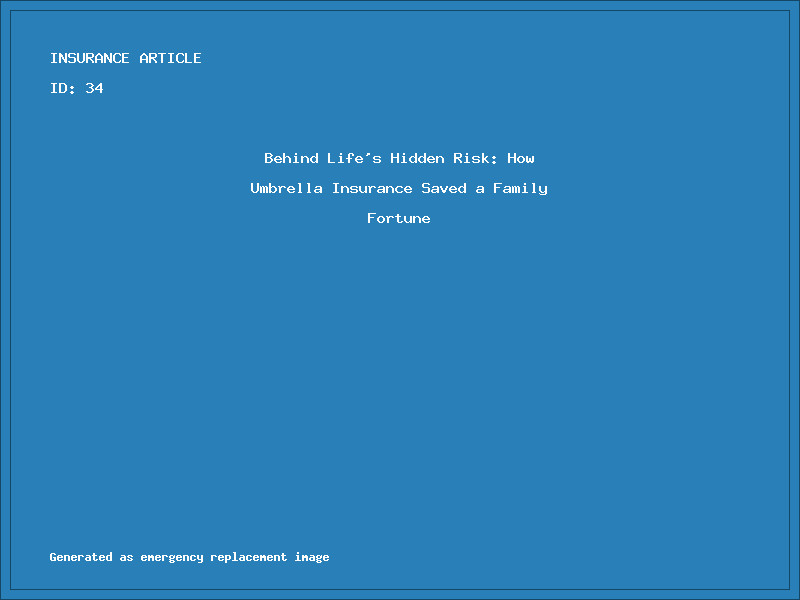It was supposed to be a routine family gathering at the Anderson home in suburban Seattle. David and Susan Anderson had invited friends and neighbors for their annual summer barbecue—a tradition spanning 15 years. Among the guests was 10-year-old Mia Bennett, the daughter of longtime neighbors. When Mia asked if she could swim in the Andersons' pool, Susan naturally said yes. What happened next would trigger a cascade of events that threatened to bankrupt the family and ultimately revealed the critical protection most Americans don't realize they need until it's too late.
When Everything Changed in an Instant
While supervising the children, Susan briefly stepped inside to answer a phone call. During those few minutes, Mia dove into the shallow end of the pool, struck her head on the bottom, and suffered a severe spinal cord injury. The resulting medical care, emergency services, and subsequent surgeries cost over $375,000 in just the first three months. Doctors projected lifetime care costs would exceed $4.2 million.
"It was devastating on every level," David recalls. "We were heartbroken for Mia and consumed with guilt about what happened. Then the legal papers arrived, and we realized our family's financial security was also at stake."
The Bennetts filed a liability lawsuit seeking $5 million in damages. The Andersons' homeowners insurance policy had liability limits of just $300,000—a fraction of what was being sought.
"I remember sitting at our kitchen table with Susan, looking at our policy documents and realizing we could lose everything," David says. "Our home, our retirement savings, even our future earnings could be at risk. It was the most helpless feeling in the world."
Then their insurance agent mentioned something the Andersons had all but forgotten—five years earlier, at their agent's insistence, they had purchased a $2 million umbrella liability policy for about $380 per year. This separate insurance policy, which the Andersons had barely thought about since purchasing it, would now determine their financial fate.
The Financial Force Field Few Americans Have
Umbrella insurance represents one of the most significant disparities between what insurance professionals recommend and what consumers actually purchase. While over 95% of insurance agents and financial planners report recommending umbrella policies to their clients, only about 10% of American households carry this coverage, according to industry data.
"It's the most important insurance policy that most people don't have," explains insurance expert Richard Martinez, who has analyzed liability claims for over 25 years. "For roughly the cost of a daily coffee, umbrella insurance provides protection that can literally save your financial life when standard policies reach their limits."
Umbrella insurance provides additional liability coverage beyond the limits of homeowners, auto, or boat insurance policies. It typically covers:
- Bodily injury liability
- Property damage liability
- Legal fees and costs
- Personal liability situations like defamation, false imprisonment, and more
What makes umbrella policies unique is their extraordinary value proposition. For approximately $150-$300 per year for a $1 million policy, consumers receive protection that would cost thousands if purchased as increased limits on primary policies. Yet despite this exceptional value, umbrella policies remain dramatically undersold and underpurchased.
"There's a perception disconnect," explains consumer psychologist Dr. Eleanor Chen. "People readily insure physical assets like homes and cars for their full value but are reluctant to adequately protect their income and assets against liability claims, which statistically pose a greater financial threat to most households."
This disconnect creates profound financial vulnerability. A 2022 analysis of personal injury settlements found that 17% of cases resulted in judgments exceeding $1 million, with the average liability claim for serious injuries exceeding $600,000. These figures have increased approximately 4% annually, outpacing inflation.
When Standard Coverage Falls Catastrophically Short
The shortfall between standard insurance coverage and actual financial exposure is substantial for most Americans. Consider these typical policy limits:
- Auto liability: $100,000-$300,000 per accident
- Homeowners liability: $100,000-$500,000
- Boat/watercraft liability: $100,000-$300,000
Yet courts routinely award damages far exceeding these amounts. Recent high-profile cases include:
- $1.2 million awarded after a teenager visiting a friend's home suffered a trampoline injury
- $2.3 million judgment against a homeowner whose dog bit a delivery driver, causing nerve damage
- $3.5 million settlement when a backyard tree fell onto a neighbor's home during a storm, with the court finding the homeowner neglected warnings about the tree's condition
- $4.1 million judgment against a driver who caused an accident resulting in another driver's traumatic brain injury
"Standard insurance policies were never designed to cover catastrophic liability scenarios," explains Martinez. "They're meant for the statistical majority of claims that fall below certain thresholds. When cases exceed those limits, umbrella policies become essential financial safeguards."
In the Andersons' case, their $300,000 homeowners liability would have been exhausted just covering Mia's initial medical expenses, leaving millions in potential damages unprotected. Their umbrella policy filled this gap.
The Anderson Resolution: From Catastrophe to Closure
When their umbrella insurance carrier took over the Anderson case, the dynamic shifted immediately. The carrier assigned a specialized legal team experienced in catastrophic injury claims and began a thorough investigation.
"Suddenly we had sophisticated legal representation and resources we could never have afforded on our own," notes David. "The insurer's attorneys handled everything professionally while remaining sensitive to the human tragedy underlying the case."
Through a structured settlement negotiation, the umbrella insurer ultimately reached an agreement with the Bennetts for $1.85 million. This amount provided for Mia's long-term care needs while protecting the Andersons from financial ruin.
"Without the umbrella policy, we would have been forced to liquidate our retirement accounts, sell our home, and potentially face bankruptcy," David explains. "Even then, it likely wouldn't have covered the full judgment, meaning our wages could have been garnished for decades. The policy literally saved our financial lives."
What many policyholders don't realize is that umbrella coverage typically includes legal defense costs outside the policy limits. This meant the Andersons' $2 million in coverage remained fully available for the settlement, with the insurer covering all legal expenses separately.
"The legal defense component alone was worth more than a decade of premium payments," notes their insurance agent, Michael Torres. "The Andersons had paid roughly $1,900 in total premiums over five years. Their insurer spent approximately $143,000 on legal representation before reaching the settlement."
Surprising Liability Risks Hiding in Everyday Life
While swimming pool accidents represent a well-recognized liability risk, insurance experts point to numerous other exposure points that most consumers overlook:
Social Media Activity
In 2021, a North Carolina homeowner faced a $1.75 million defamation judgment after posting negative allegations about a contractor online. Her homeowners policy excluded defamation, but her umbrella policy covered the judgment with its broader definition of personal injury.
"Social media has dramatically increased personal liability exposure," explains social media attorney Jordan Williams. "People post comments that would constitute slander or defamation if spoken, not realizing digital statements often create greater liability due to their permanence and broader distribution."
Teen Drivers
Parents often underestimate their liability exposure through teenage drivers. When 17-year-old Ryan Matthews caused a multi-car accident resulting in several injuries, the resulting claims exceeded $1.3 million. His parents were legally responsible for the portion exceeding their $300,000 auto liability limits.
"Adding a teenage driver to your household effectively doubles your liability risk overnight," notes Martinez. "Umbrella coverage becomes particularly crucial during these high-risk years."
Home Businesses
When photographer Lisa Chen had a client trip over equipment during an in-home session, resulting in a broken hip, her homeowners policy denied coverage, citing business exclusions. Her umbrella policy covered the $425,000 claim due to its broader protection for mixed personal/business activities conducted in the home.
"Many standard policies contain business exclusions that create dangerous coverage gaps for the millions of Americans now working partially or fully from home," explains insurance analyst Maria Vasquez. "Umbrella policies often provide broader protection for incidental business activities."
Volunteer Activities
While serving as a volunteer youth soccer coach, Robert Patel faced a $650,000 lawsuit from parents alleging negligent supervision when a child was injured during practice. His umbrella policy covered legal defense costs and the eventual $180,000 settlement.
"Volunteer activities create substantial liability exposure that most people never consider," notes nonprofit risk management consultant Elena Rodriguez. "School, sports, and community volunteers often face claims their primary insurance wasn't designed to address."
Rental Properties
When landlord Thomas Wong was sued after a tenant's guest fell down poorly lit stairs, his landlord policy limit of $500,000 fell short of the $1.2 million judgment. His umbrella policy covered the difference and legal costs.
"Investment property ownership dramatically increases liability exposure," explains real estate attorney Sarah Johnson. "Landlords face premises liability, discrimination claims, wrongful eviction suits, and numerous other risks that frequently exceed primary policy limits."
Who Needs Umbrella Insurance: The Asset Myth
One persistent misconception about umbrella insurance is that it's primarily for the wealthy. Insurance professionals strongly disagree with this perspective.
"The most dangerous myth about umbrella policies is that you only need one if you have substantial assets to protect," explains financial planner Rebecca Torres. "In reality, those with fewer assets may need this protection even more urgently."
This counterintuitive reality stems from how liability judgments are satisfied. When damages exceed insurance coverage, courts can garnish future wages, attach liens to property, and claim future inheritances or earnings. Since most states limit what assets creditors can seize in bankruptcy, those with fewer assets often face greater long-term financial consequences from major liability judgments.
"If a multimillionaire faces a liability claim exceeding their insurance, they might pay the difference and move on," notes Torres. "But if a middle-class family with modest savings faces the same situation, they could experience decades of financial hardship through wage garnishment and restricted credit."
This reality makes umbrella coverage particularly important for:
- Young professionals with high future earning potential but limited current assets
- Middle-income families with multiple liability exposure points (homes, cars, teen drivers)
- Small business owners whose personal and professional assets may be intertwined
- Rental property owners facing tenant-related liability
- Active volunteers in schools, sports, and community organizations
- Frequent social hosts who entertain guests in their homes
"I advise clients to think about umbrella coverage not just in terms of what they own now, but what they might earn over the next 20 years," explains Torres. "For most working professionals, future income represents their largest financial asset—and potentially their greatest exposure in a liability judgment."
The New Liability Landscape: Why Exposure Is Increasing
Several societal trends have significantly increased personal liability exposure in recent years:
Rising Medical Costs
With medical care inflation consistently outpacing general inflation, injury-related damages have grown substantially. A liability claim involving serious injuries that might have settled for $250,000 in 2000 often exceeds $1 million today, driven primarily by increased medical costs.
"Healthcare cost inflation directly drives liability settlement growth," explains healthcare economist Dr. James Chen. "When a catastrophic injury occurs, the largest portion of damages typically relates to future medical expenses, which have increased approximately 175% over the past two decades."
Social Media Evidence
Digital platforms have revolutionized how liability claims are proven and valued. Social media posts, location data, and digital communications now provide unprecedented evidence in liability cases.
"Social media has transformed liability litigation," notes digital evidence attorney Michael Kim. "When someone posts about home renovations they completed themselves, they're potentially creating evidence for a future claim if someone is injured on their property. When they share photos of social gatherings where alcohol is served, they're documenting potential social host liability."
Evolving Legal Standards
Courts have progressively expanded liability theories in many jurisdictions, creating responsibility in situations that previously might not have resulted in legal exposure.
"Legal liability has gradually expanded over decades," explains personal injury attorney Sarah Davis. "Actions or conditions that wouldn't have created liability twenty years ago are now routinely resulting in significant judgments. This 'liability creep' affects everyone, regardless of wealth or status."
Increasing Judgment Amounts
The average personal liability judgment involving serious injury has increased approximately 7% annually over the past decade, significantly outpacing both inflation and wage growth. This trend makes previously adequate coverage limits increasingly insufficient.
"We're seeing more seven-figure personal liability judgments than ever before," notes Martinez. "Amounts that would have been considered extraordinary ten years ago have become relatively common in cases involving permanent injuries or disabilities."
The Coverage Gap: Why Consumers Remain Vulnerable
Despite the clear value proposition and increasing risk exposure, umbrella policy adoption remains stubbornly low. Insurance professionals point to several factors contributing to this protection gap:
Optimism Bias
"People systematically underestimate their personal risk exposure," explains behavioral economist Dr. Thomas Nguyen. "The same cognitive bias that leads people to believe they're above-average drivers makes them discount their liability exposure. They recognize these events happen but don't believe they'll happen to them."
Invisibility of Benefits
Unlike auto or home insurance, where consumers can easily visualize the covered risk (car accidents, house fires), umbrella liability scenarios are more abstract and diverse, making the benefits less immediately apparent.
"Insurance products tend to sell better when the covered risk is concrete and emotionally resonant," notes marketing psychologist Dr. Elena Vasquez. "The abstract nature of liability claims makes it harder for consumers to connect emotionally with umbrella coverage benefits."
Coverage Complexity
Umbrella policies involve understanding how multiple insurance products interact, creating a complexity barrier for many consumers.
"When insurance concepts become technically complex, many consumers disengage from the decision process entirely," explains Vasquez. "This complexity avoidance leads to defaulting to minimal coverage without fully evaluating exposure."
Sales Process Challenges
Insurance agents report that umbrella policies are more time-intensive to explain but generate relatively small commissions, creating misaligned incentives in some sales environments.
"The economics of insurance sales sometimes work against proper umbrella coverage," notes insurance industry consultant Richard Baker. "Agents earn substantially more selling a new auto policy than adding an umbrella to an existing customer's portfolio, despite the umbrella potentially providing greater client value."
Selecting the Right Coverage: Beyond the Basics
For consumers considering umbrella coverage, insurance professionals recommend evaluating several factors beyond just the coverage limit:
Defense Coverage Structure
Premium umbrella policies provide legal defense costs outside policy limits, preserving the full coverage amount for potential settlements. Lower-quality policies may include legal costs within the coverage limit, effectively reducing available settlement funds.
"The distinction between defense inside or outside limits can be crucial in complex liability cases," explains insurance attorney Daniel Park. "When defense costs are outside limits, your full coverage remains available regardless of legal expenses."
Coverage Triggers
Some umbrella policies only activate when underlying insurance is exhausted, while others will "drop down" to provide primary coverage for certain claims excluded by underlying policies.
"Drop-down coverage creates substantially broader protection," notes Park. "It essentially fills coverage gaps rather than just providing excess limits above existing coverages."
Uninsured/Underinsured Motorist Extension
Premium umbrella policies extend uninsured/underinsured motorist protection beyond auto policy limits, protecting against at-fault drivers with insufficient coverage.
"Without this extension, you could have $2 million in liability protection for damage you cause but limited protection if someone else causes similar injuries to you or your family," explains Martinez. "This creates an asymmetric protection situation many consumers don't recognize."
Worldwide Coverage
Quality umbrella policies provide worldwide protection, while basic policies may limit coverage geographically or exclude certain international situations.
"International coverage becomes particularly important for travelers," notes global risk consultant Elena Kim. "Liability scenarios in foreign countries can involve complex jurisdictional issues that require specialized legal resources."
The Financial Math: Affordable Protection for Catastrophic Risk
The extraordinary value proposition of umbrella insurance becomes clear when examining typical premium structures:
| Coverage Amount | Typical Annual Premium | Daily Cost |
|---|---|---|
| $1 million | $150-$300 | $0.41-$0.82 |
| $2 million | $225-$375 | $0.62-$1.03 |
| $3 million | $275-$450 | $0.75-$1.23 |
| $5 million | $375-$525 | $1.03-$1.44 |
"When clients realize comprehensive $1 million umbrella protection costs less daily than their coffee habit, the decision becomes much clearer," notes financial planner Jasmine Rodriguez. "Few financial products provide such catastrophic risk protection for so little cost."
For consumers determining appropriate coverage limits, Rodriguez recommends a simple formula: "Calculate your net worth, add five years of income, then select the next highest million in coverage. This accounts for both current assets and future earnings potential."
Under this formula, a household with $300,000 in assets and $100,000 annual income would need at least $800,000 in protection (assets plus five years of income), suggesting a $1 million umbrella policy.
The Anderson Family: Life After Liability
Three years after their pool accident, the Andersons have rebuilt their lives while maintaining a relationship with Mia and her family. The structured settlement provides for Mia's ongoing care needs, and both families have worked to maintain their friendship despite the traumatic circumstances.
"The insurance protection gave everyone breathing room to work through an impossible situation with compassion rather than desperation," David reflects. "Without adequate coverage, the financial pressures could have destroyed relationships along with finances."
The experience transformed David into an advocate for proper liability protection. He regularly speaks to community groups about umbrella coverage and has counseled numerous friends and colleagues about reviewing their insurance portfolios.
"I never thought about insurance as something that would save our family, both financially and emotionally," he notes. "But that's exactly what happened. For less than we spend annually on coffee, we had protection that made all the difference when we needed it most."
While the Andersons' experience represents a worst-case scenario that most families will fortunately never face, insurance professionals emphasize that such catastrophic events are precisely why umbrella coverage exists.
"Insurance, at its core, isn't about covering predictable expenses," concludes Martinez. "It's about protecting against low-probability events with devastating financial consequences. By that standard, umbrella liability coverage may be the purest form of insurance protection available—and the most overlooked."






